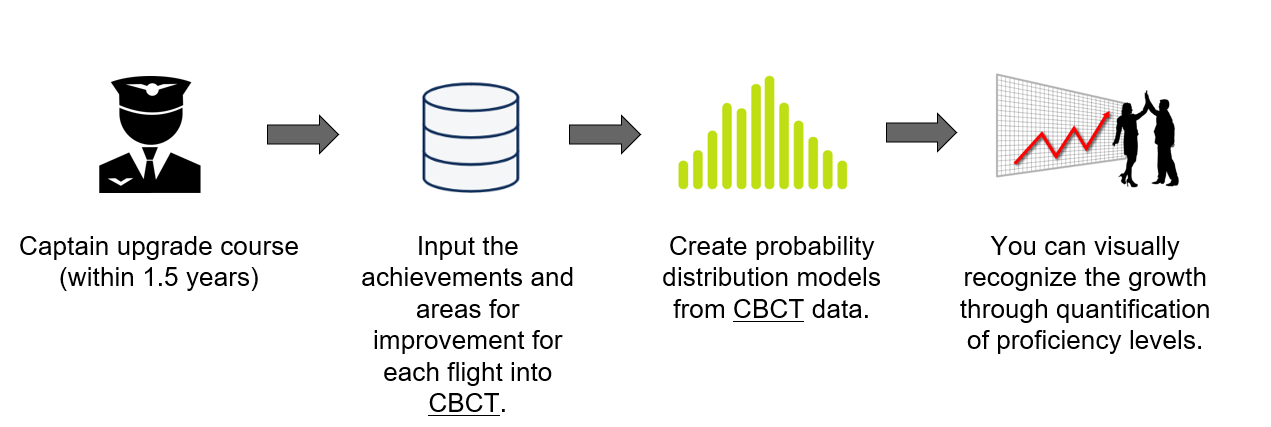Promoting digital transformation (DX) in pilot training
- succeeded in constructing a stochastic model for growth processes during captain upgrade training -
October 6, 2023 (JST)
Japan Aerospace Exploration Agency (JAXA)
Japan Airlines Co., Ltd.
The Japan Aerospace Exploration Agency (JAXA) (Headquarters: Chofu-shi, Tokyo, President: YAMAKAWA Hiroshi, hereinafter referred to as “JAXA”) and Japan Airlines Co., Ltd. (Headquarters: Shinagawa-ku, Tokyo, President: AKASAKA Yuji, hereinafter referred to as “JAL”) have successfully developed a probabilistic model (*1) to describe the pilot’s growth process during captain upgrade training, further supporting JAL’s digital transformation (DX) initiative in pilot training. JAXA is dedicated to advance digital transformation in society by leveraging its aerospace engineering knowledge to enhance data understanding. JAL is committed to providing all customers with safer air travel by reinforcing pilot human resource development with scientifically backed data.

Although the current rate of aviation accidents is low, pilot training has recently focused on improving “competency” to train pilots to be “resilient,” so that they can calmly and accurately assess the situation and recover from it, no matter what they encounter. There is a particular need to improve non-technical skills, such as situational awareness, decision making, and interpersonal skills, necessary for pilots to work together and carry out their duties safely. Measuring these skills are challenging, and accurate assessment is necessary to provide feedback for growth.
JAL has been promoting DX by internally developing an advanced training data recording system called CBCT (Competency Based Check and Training) in collaboration with the Civil Aviation Bureau of the Ministry of Land, Infrastructure, Transport, and Tourism. With JAXA's expertise in statistical analysis, utilizing survival analysis (*2) crucial in aerospace engineering, JAL and JAXA jointly constructed a probabilistic model that describes pilot’s growth processes based on thousands of flight data accumulated in the CBCT. The results were published on IEEE Transactions on Reliability (Early Access, DOI:10.1109/TR.2023.3294021External Link). Furthermore, JAL and JAXA successfully classified the growth process into several patterns. The two organizations jointly presented the findings at the IEEE Conference on Systems, Man, and Cybernetics held in Hawaii, USA, on October 1-4, 2023.
These probabilistic models can quantitatively express the fundamental characteristics of the pilot's growth process, which was previously understood intuitively. They are expected to assist training instructors in accurately grasping the signs of improvement and training effects of trainees quantitively for more effective training. This will also contribute to shortening the training period and alleviating the pilot shortage in the future.
JAL, in cooperation with JAXA, will develop a system that incorporates the results of this project into the CBCT system, ensuring safer and more secure air travel for all customers through the implementation of an advanced pilot training environment. JAXA believes that this achievement applies to the general growth process beyond pilot training and will work to facilitate DX in wider society by applying this growth process in various specialized fields where social demand is increasing, such as re-skilling, to create social value.
【Abstract of the journal paper】

We found that the probability distribution of the number of granting “improvement required flag” per flight, recorded when improvement in competency is desired, follows the LMR distribution(*2) based on the probability distribution used in “survival analysis(*3)”. By interpreting one of the parameters as the training growth step, we could mathematically model how the number of flags decreases according to the step-up of training (left figure).
(*1) A general term that mathematically expresses the probability that a certain phenomenon will occur, and here, it represents the transition of the probability that a flag recorded during training will be given a specific number of times per flight.
(*2) LMR: Limit of marginal distribution of Ryu’s bivariate exponential distribution.
(*3) Statistical analysis to analyze such as equipment failure time or patient survival time.
This work was supported by JSPS KAKENHI Grant Number 21K14350.
Related Links
- Aviation Technology Directorate
- Japan Airlines Co., Ltd. External Link